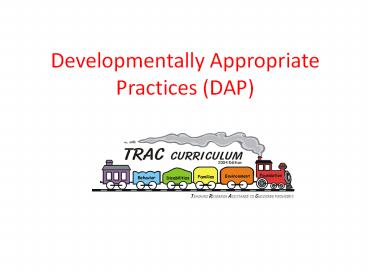Developmentally Appropriate Practices (DAP) PowerPoint PPT Presentation
Title: Developmentally Appropriate Practices (DAP)
1
Developmentally AppropriatePractices (DAP)
2
Developmentally Appropriate Practices
3
Guidelines for Practice
- Creating a caring community of learners
- Teaching to enhance development and learning
- Constructing appropriate curriculum
- Assessing childrens learning and development
- Establishing reciprocal relationships with
families
4
(No Transcript)
5
Teaching to Enhance Development and Learning
- Teachers respect, value and accept children
- Teachers get to know each child and establish
positive relationships with families - Teachers create intellectually challenging,
responsive environment - Teachers make plans to enable children to attain
key curriculum goals across disciplines
6
Teaching to Enhance Development and Learning
- Teachers foster childrens collaboration with
peers - Teachers develop, refine and use wide repertoire
of teaching strategies - Teachers facilitate development of responsibility
and self-regulation
7
Constructing Appropriate Curriculum
- Provides for all areas of development
- Includes broad range of content areas
- Builds on what children already know
- Curriculum integrated across subject matter
divisions to make connections
8
Constructing Appropriate Curriculum
- Promotes development of knowledge and
understanding, processes and skills - Supports childrens home culture and language
- Curriculum goals are realistic and attainable
9
Assessing Childrens Learning and Development
- Assessment is ongoing, strategic, and purposeful
- Assessment content reflects progress toward
learning and developmental goals - Assessments are appropriate to age and experience
- Decisions are based on multiple sources of
information
10
Assessing Childrens Learning and Development
- Developmental assessments and observations used
to identify children who have special learning or
developmental needs - Assessment recognize individual variation
- Assessment address what children can do
independently and with assistance
11
Establishing reciprocal relationships with
families
- Relationships require mutual respect,
cooperation, shared responsibility, negotiation - Teachers work in collaboration with families
- Parents welcome in program, participate in
decisions - Teachers acknowledge parents choices and goals,
are respectful of parent preferences and concerns
12
Establishing reciprocal relationships with
families
- Teachers and parents share knowledge of child and
continue to communicate - Teachers involve families for assessing and
planning - Teachers link families to social services
- Teachers share information as children move from
one program to another
13
Activity
- List concrete activities that you do in your
programs to address your star point (guideline
for practice).
14
Activity
- Individually or with a partner, please complete
the DAP quiz!

